Does Steam Kill Bed Bugs: Effective Heat Treatments Explained
When tackling a bed bug infestation, steam treatment emerges as a highly effective solution. The intense heat from steam is deadly to both bed bugs and their eggs, offering a chemical-free alternative to traditional pesticides. Steam can penetrate fabrics, cracks, and crevices where bed bugs often hide, providing a comprehensive approach to eradicating the problem. However, selecting the right steamer and mastering the proper technique are crucial to ensuring a thorough treatment.
This involves more than simply passing a steamer over an infested area, requiring a deep understanding of bed bug behavior, the science behind steam treatment, and integrating this method with broader pest control strategies.
Key Takeaways
Killing bed bugs and their eggs without relying on chemicals is possible through steam treatment. To be effective, it’s crucial to comprehend bed bug behavior and master proper steaming techniques. For optimal results, consider combining steam treatment with other pest control methods.
Understanding Bed Bugs
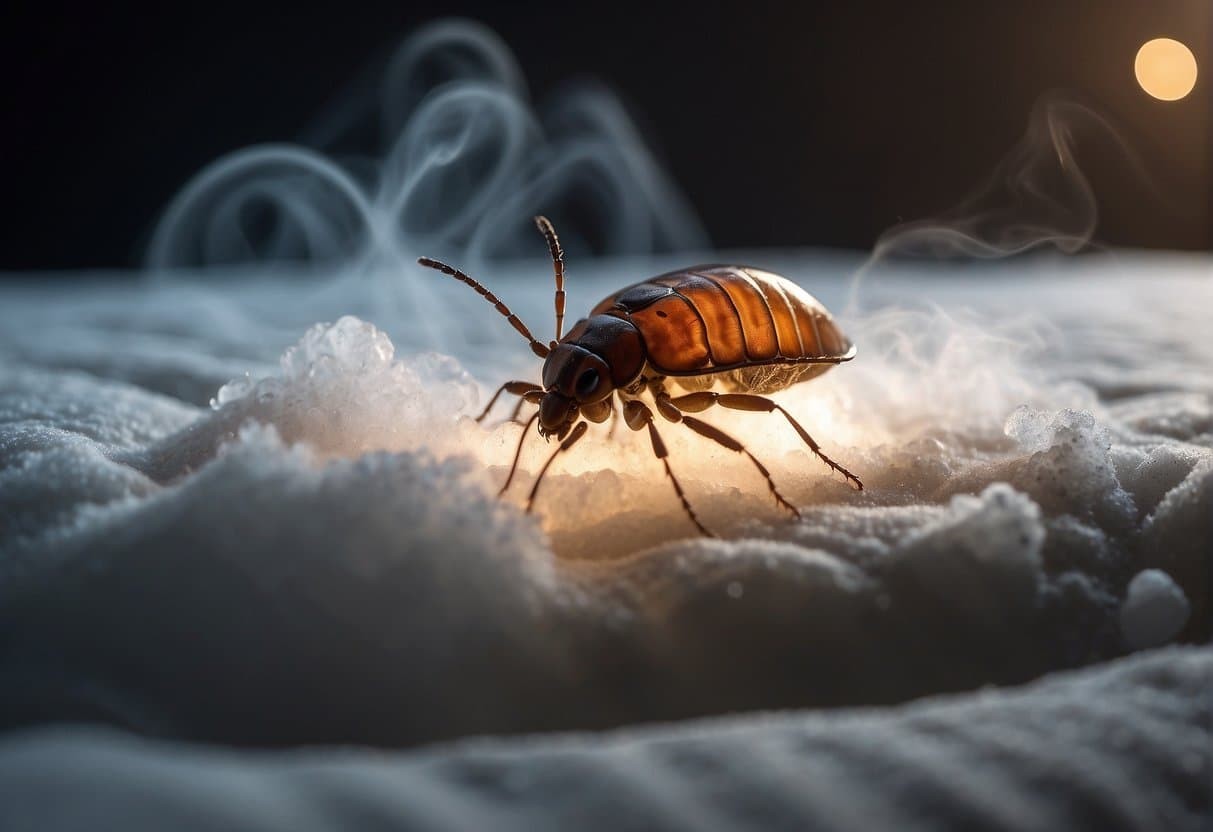
To successfully combat bed bugs, it’s essential to develop a comprehensive plan rooted in a deep understanding of these pesky insects. This involves grasping their stealthy behaviors, the various stages of their life cycle, and the key factors that contribute to their persistence. By doing so, you’ll be better equipped to outsmart them, ultimately leading to a victorious outcome.
Biology of Bed Bugs
Bed bugs, specifically Cimex lectularius, may seem harmless at first glance due to their diminutive size and nocturnal habits. However, these tiny insects have a voracious appetite for human blood, and their flat, oval bodies – roughly the length of an apple seed – can pack a significant punch. Despite their small stature, bed bugs are notorious for their remarkable tenacity, which stems from their protective exoskeletons.
These hardy structures shield them from physical harm, allowing them to thrive in even the most challenging environments.
Lifecycle and Reproduction
The life cycle of a bed bug starts with the emergence of a tiny egg, measuring around 1mm in size. These eggs hatch into nymphs that rely on a blood meal to molt and progress through five juvenile stages. A distinctive feature of these nymphs is their skin-shedding behavior after each feeding session. The entire process from egg to adult takes approximately five weeks at room temperature.
Once adults, bed bugs can survive for several months, with females capable of laying up to three to five eggs daily. This rapid reproductive cycle can quickly lead to a substantial infestation if left unchecked.
Common Hiding Spots
Bed bugs are notorious for their ability to hide and conceal themselves. Their preferred hiding spots include mattress seams, box springs, headboards, and bed frames, where they can remain close to their food source – you. However, they don’t stop there. These unwanted critters can also be found in unexpected places such as electrical outlets, behind wallpapers, in upholstery, baseboards, carpet edges, and even personal belongings.
It’s crucial to regularly inspect these areas to detect an infestation early on. By understanding the characteristics and habits of bed bugs, you’ll be better equipped to identify and tackle these parasites. Remember, they’re not confined to beds alone; they can thrive almost anywhere in your home, waiting for the cover of night to feed on your blood. Their resilience and ability to multiply quickly make them formidable pests that require attention and vigilance.
The Science of Steam Treatment
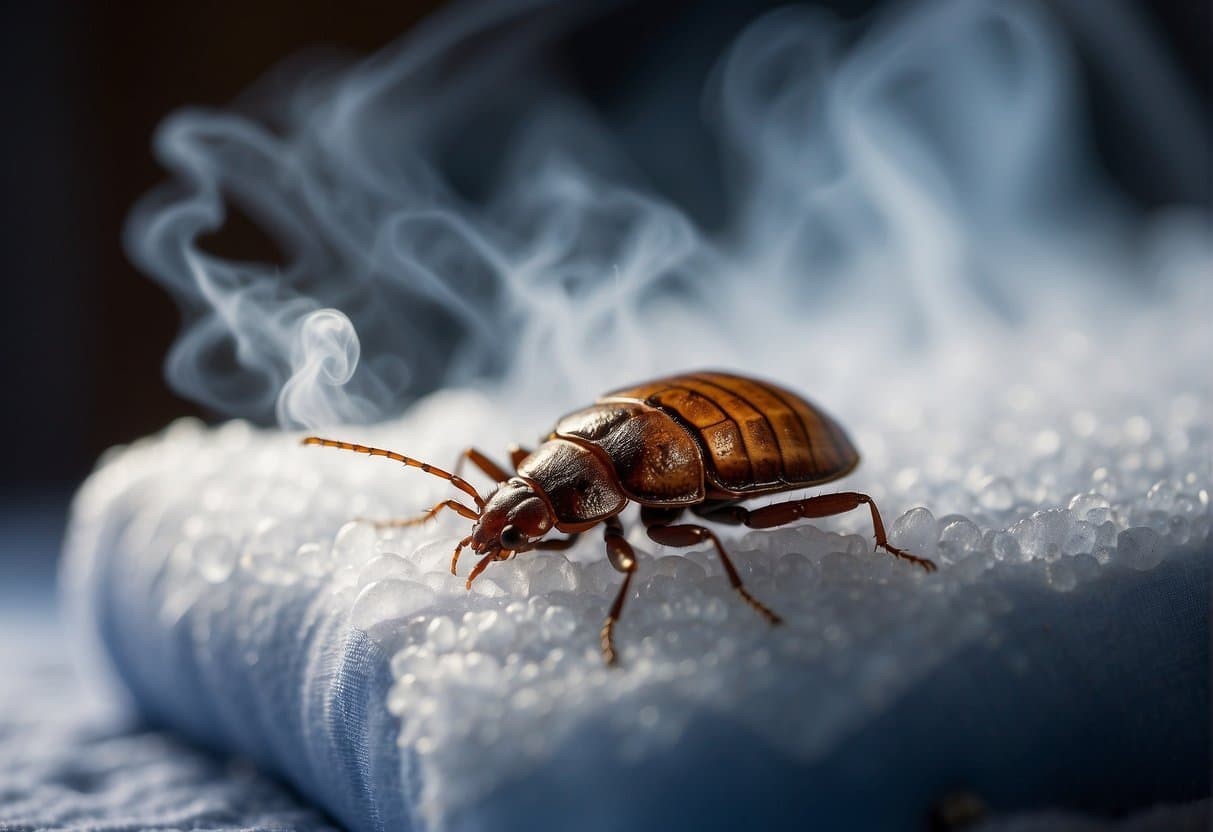
In the midst of a bed bug infestation, steam treatment emerges as a formidable approach to eliminate these unwanted guests. By harnessing the power of high temperatures, this method effectively disrupts the bed bugs’ life cycle, rendering them unable to survive or reproduce.
How Steam Affects Bed Bugs
Bed bugs are notorious for their ability to evade detection, hiding in tiny crevices and seams. However, their Achilles’ heel lies in their susceptibility to extreme heat, specifically steam treatment. The high temperatures, exceeding 130°F, are lethal to both adult bed bugs and their eggs, rendering the treatment a highly effective means of eradication.
Furthermore, the steam’s penetrating ability allows it to reach even the most inaccessible hiding spots, making it a valuable tool in the fight against these pesky pests.
Temperature and Effectiveness
To achieve thorough eradication, it’s essential to ensure the steam temperature reaches at least 130°F at the point of contact. This can be verified using an infrared thermometer, which provides accurate readings for optimal effectiveness. While some experts advocate for even higher temperatures to guarantee a kill, the emphasis is on delivering sufficient heat during treatment.
By meeting these temperature thresholds, you can be confident in your ability to effectively treat and eliminate any unwanted pests.
Steam Versus Chemical Treatments
Many consider steam treatment as a chemical-free alternative to traditional insecticides, particularly appealing given bed bugs’ demonstrated resistance to various chemical treatments. Unlike chemicals, which can pose health risks and environmental concerns, steam offers a safe and eco-friendly approach that targets both the insects and their eggs, providing a comprehensive solution without the risk of developing resistance.
Steam Treatment Process
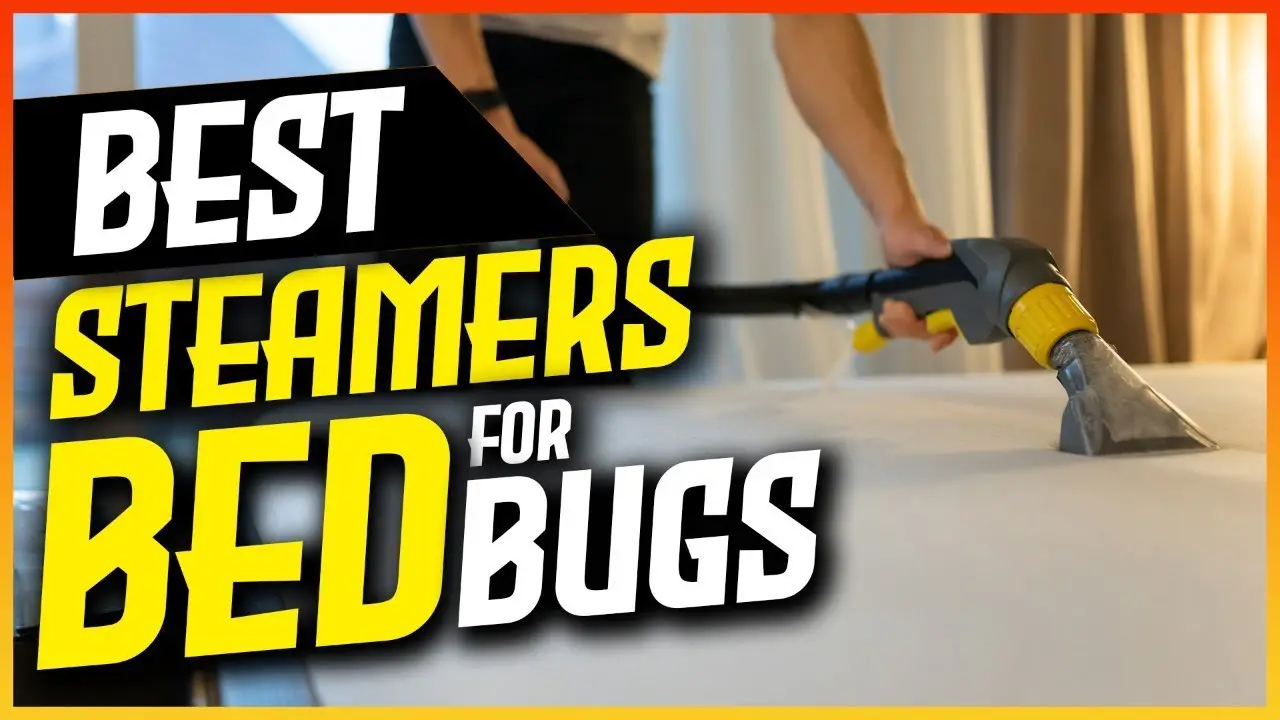
When it comes to eradicating bed bugs, a thorough and precise approach is crucial. Steam plays a vital role in effective pest control by disrupting the insects’ ability to survive and reproduce. This section will walk you through a step-by-step process for a meticulous steam treatment that yields optimal results in eliminating these resilient pests from your environment, leaving your space clean and bed bug-free.
Preparation for Steam Treatment
To kick-start your steam-based bed bug elimination process, it’s essential to prepare the space thoroughly. Start by decluttering the room to uncover any hiding spots where these pesky critters might be lurking. Next, give the area a thorough vacuuming to remove any loose bed bugs or eggs that may have fallen off the furniture.
Don’t forget to inspect the area carefully to identify areas of infestation – focus on the mattress, carpet, upholstery, and crevices, as these are common hiding spots for bed bugs. Finally, select a steam cleaner with a large water capacity and multiple nozzles to ensure effective coverage of different surfaces and tight spaces.
Execution of Steam Cleaning
When it comes to executing steam cleaning effectively, the level of attention to detail and technique employed plays a crucial role. To get started, fill your steam cleaner with water and heat it up to the recommended temperature, typically above 120°F (49°C). As you begin the process, prioritize less sensitive areas before moving on to delicate fabrics to prevent any potential damage.
Move the nozzle slowly along surfaces, ensuring that the steam has sufficient time to penetrate into even the most hard-to-reach bed bug hiding spots. In particular, pay close attention to seams, tufts, and edges of mattresses, as well as the corners and edges of carpets and upholstery. Make sure to utilize the different nozzles provided by your steam cleaner for optimal results on various surfaces – a narrow nozzle is ideal for crevices, while a floor nozzle is better suited for larger areas.
Remember that it’s essential for the steam to make direct contact with bed bugs in order to be lethal. While techniques may vary depending on the surface being cleaned, adopting a slow and methodical approach tends to yield more effective results than rushing through the process.
Post-Treatment Considerations
To ensure the success of your steaming treatment and prevent future infestations, it’s crucial to take several key steps. First, allow all surfaces to dry completely, as excess moisture can create an environment conducive to mold growth. Additionally, encase your mattress in a bed bug-proof cover to prevent any lingering bugs from re-establishing themselves.
Regularly inspect the treated areas for any signs of a returning infestation, and consider a follow-up treatment or consult with a pest control specialist if you experience persistent issues. By being proactive and vigilant after steaming, you can confidently say goodbye to those pesky bed bugs and enjoy a pest-free living space. With proper preparation, execution, and post-treatment care, steam treatment can be a highly effective, non-toxic, and eco-friendly solution for eliminating bed bugs.
Selecting the Right Steamer
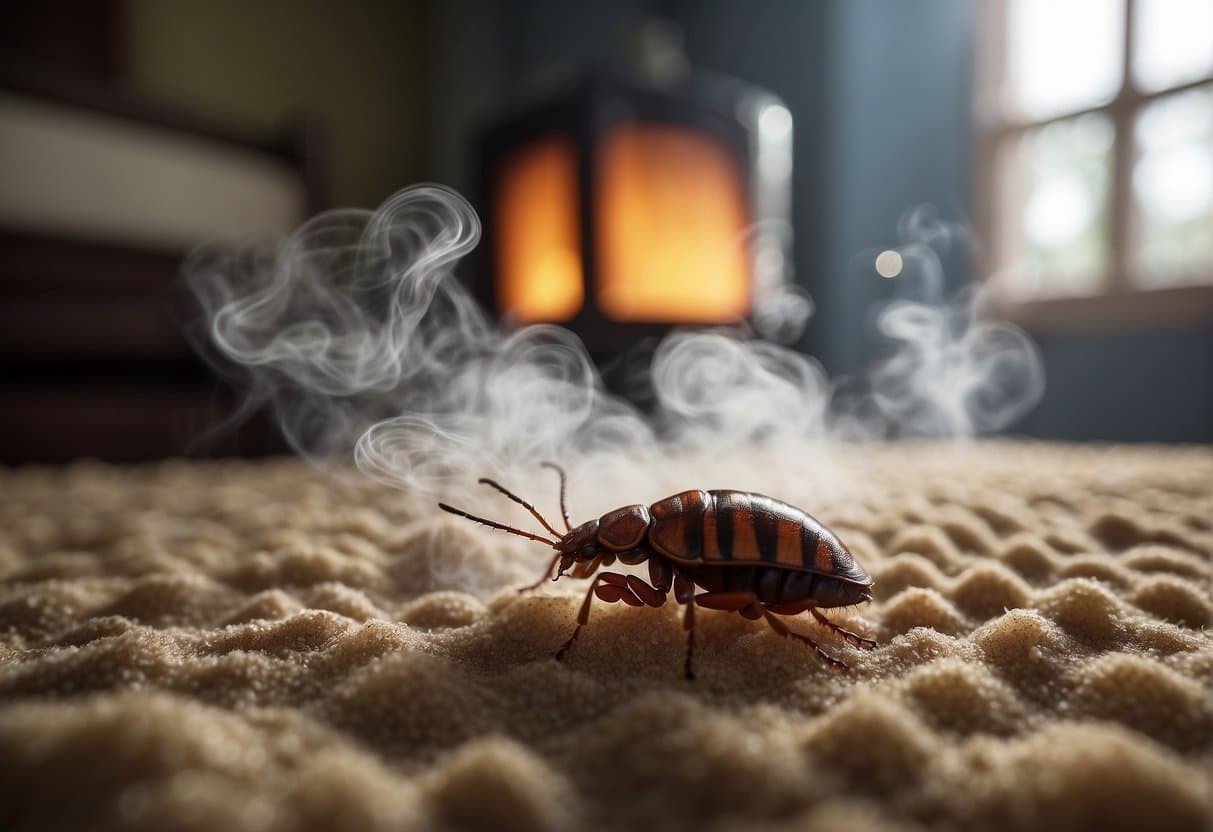
In order to successfully eliminate bed bugs from infested areas, selecting a suitable steamer is essential. A reliable steam cleaner can effectively eradicate these unwanted pests, making it an efficient solution for bed bug treatment.
Features of an Effective Steamer
To combat bed bugs effectively, it’s crucial to utilize a steamer capable of reaching extremely high temperatures. Bed bugs and their eggs are rendered powerless at around 212°F. When selecting a steamer, consider the following key features: High Temperature: A peak temperature of at least 200°F is essential for ensuring the complete elimination of bed bugs. Large Water Tank: Opt for a minimum 1-gallon tank to minimize refills and maintain a steady stream of steam production.
Continuous Steam: The steamer should offer a continuous flow of steam, allowing you to cover areas thoroughly without the need to pause and reheat. One top-rated model that meets these criteria is the Dupray Neat Steam Cleaner. This device provides a consistent, high-temperature steam ideal for bed bug extermination.
Commercial vs. Consumer Steam Cleaners
While consumer steam cleaners are ideal for small areas and infrequent use, they may not deliver the high temperatures necessary to eliminate bed bugs or provide continuous steam flow. In contrast, commercial-grade steamers are designed for prolonged use and durability, offering powerful and consistent steam that can effectively treat infested areas. Although they come at a higher price point, their performance justifies the investment.
While a consumer steamer may suffice for occasional use, a commercial-grade steamer like the Dupray Neat Steam Cleaner could be a better long-term solution for frequent or large-scale treatments.
Safety and Precautions
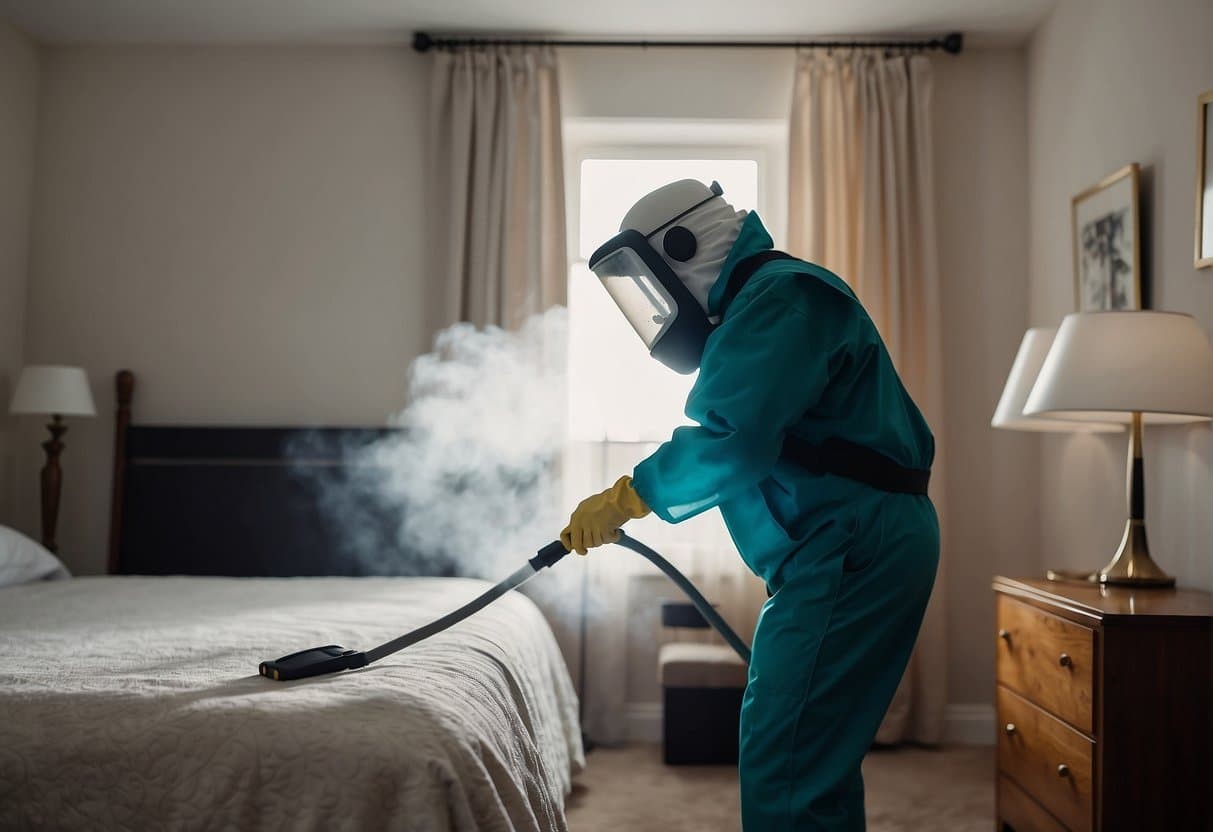
As you prepare to embark on your bed bug eradication journey with steam, it’s crucial to acquaint yourself with the essential safety measures and precautions to safeguard both yourself and your home. While steam treatment is a potent tool in the fight against these unwanted pests, it also presents its own unique set of risks and considerations, particularly when working with delicate or sensitive items.
By taking the time to understand these potential hazards, you can ensure a successful and safe outcome for your bed bug annihilation mission.
Risks Associated with Steam Treatment
When using steam to eliminate bed bugs, it’s crucial to balance effectiveness with safety precautions. The high heat and pressure generated by steam cleaners can be hazardous if not handled correctly. To avoid burns, wear protective gloves and direct the steam away from yourself and others. Additionally, surfaces may become scorching hot, so let them cool before handling. Beyond personal safety, it’s essential to consider your home’s structure and contents.
Steam can introduce moisture that warps wood, fosters mold growth, or damages drywall if not managed carefully. Exercise caution when using steam near electronics or outlets, as the combined heat and moisture can trigger short-circuiting or electrical hazards. When utilizing pressure from steam canisters, exercise restraint and start with low pressure settings to avoid blowing bed bugs around instead of killing them. This could inadvertently spread the infestation.
Preventing Damage to Sensitive Items
When using a steam cleaner on upholstered furniture or delicate fabric items, it’s crucial to exercise caution. While a steam cleaner may be great for hard surfaces or bare mattresses, these more fragile items require special care. Firstly, ensure the steam cleaner is safe for use on upholstery – excessive moisture can lead to water marks or even mold growth. If your model has a dry steam setting, utilize it and always test on a small, inconspicuous area before proceeding.
Additionally, be mindful of sensitive items like books, paper, or certain fabrics that may not respond well to steam. To protect these items, either remove them from the treatment area or place them in a plastic bag for safekeeping. For items that cannot withstand heat and moisture, consider an alternative method like freezing – although this approach takes longer, it’s a safer choice to prevent damage.
By prioritizing safety for both yourself and your possessions, you’ll be well on your way to an effective and accident-free bed bug eradication.
Integrating Steam Treatment with Broader Pest Control Strategies

In the comprehensive fight against bed bugs, steam treatment emerges as a powerful ally. While it’s a crucial component of any successful strategy, relying solely on steam treatment is insufficient. To effectively eradicate an infestation, it’s essential to combine this method with complementary approaches.
Complementary Methods After Steam Cleaning
While steam treatment is effective at killing bed bugs on contact by reaching temperatures lethal to them, it may not penetrate deeply enough to eliminate all hidden pests. To ensure a comprehensive approach, consider supplementing steam cleaning with vacuuming to remove dead bugs and any remaining live ones from treated areas. A vacuum cleaner equipped with a HEPA filter can help capture even the finest particles.
Following steaming, apply EPA-approved insecticides to areas where bed bugs are known to hide, using them in accordance with label instructions to minimize health risks. Additionally, consider using bed bug traps to monitor the presence of bed bugs after treatment, allowing you to assess the effectiveness of your pest control efforts and make any necessary adjustments.
Professional Extermination Services
In situations where a DIY approach is no longer sufficient, it’s crucial to seek the assistance of professional bed bug exterminators. These experts possess the knowledge and resources necessary to tackle even the most severe infestations. A comprehensive assessment by an experienced exterminator can pinpoint the extent of the problem and develop an effective treatment plan tailored to the specific situation.
Furthermore, professional exterminators may employ advanced techniques such as combining steam treatment with heat treating entire rooms to ensure that every last bed bug is eliminated. This multi-faceted approach not only increases the chances of a successful eradication but also provides peace of mind for homeowners who have struggled to contain the infestation on their own.
Maintenance and Prevention Tips
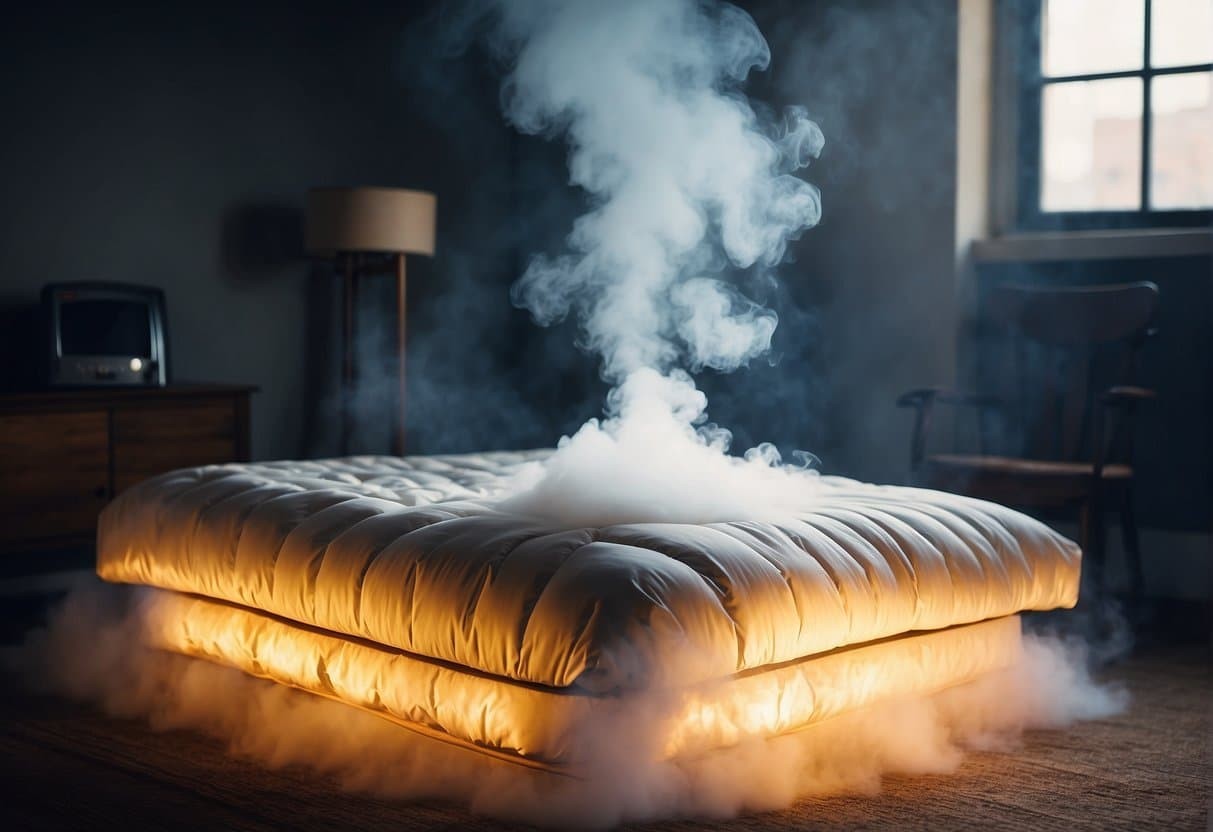
To effectively combat bed bugs, it’s essential to adopt a multi-faceted approach that extends beyond the initial application of heat treatment. This includes establishing a robust preventative routine that involves regular cleaning, decluttering, and sealing potential entry points. By creating a hostile environment through these measures, you can significantly reduce the likelihood of bed bug infestations.
Regular Cleaning Schedule
To maintain a bed bug-free environment, establishing a consistent cleaning routine is vital. This involves regularly vacuuming carpets and furniture, particularly around beds and upholstered items where bed bugs are likely to conceal themselves. Additionally, wash and heat-dry all bedding, blankets, and clothing that come into contact with the floor to eliminate any remaining bugs or eggs.
Moreover, it’s crucial to deep clean mattresses, not just for aesthetics but also to remove dust mites and bed bugs. By doing so, you’ll be able to prevent these unwanted pests from multiplying and spreading.
Reducing Clutter and Possible Hiding Spots
To effectively prevent bed bug infestations, it’s crucial to eliminate hiding spots for these unwanted pests. One key strategy involves a thorough decluttering of your living space. By reducing clutter, you’re significantly limiting the number of areas where bed bugs can conceal themselves.
A more meticulous approach requires inspecting and cleaning behind furniture, around carpet edges, and in deep crevices.
Bed bugs are notorious for their ability to squeeze into minuscule spaces, such as those found within bolts and screws of your bed frame. Additionally, storing items like clothing and linens in sealed bags or containers can prevent bed bugs from making themselves at home. By implementing these measures, you’ll be well on your way to creating a bed bug-free environment.
Sealing Entry Points
To prevent bed bugs from infiltrating your space, it’s essential to seal any potential entry points. Start by checking for tiny crevices and cracks around outlets, baseboards, window frames, and other areas where pipes and wires enter your home. Don’t forget to examine the edges of carpets and loose light switch covers, as these can also provide an opening for unwanted visitors.
By taking proactive measures to repair or replace damaged wallpaper and tighten any loose fixtures, you’ll significantly reduce the chances of bed bugs making themselves at home. Consistency is key in maintaining a bed bug-free environment, so be sure to regularly inspect your space and address any potential entry points as soon as they arise.
With vigilance and a little elbow grease, you can safeguard your home from future invasions and enjoy a peaceful night’s sleep without the threat of these pesky pests.
Measuring the Success of Steam Treatment
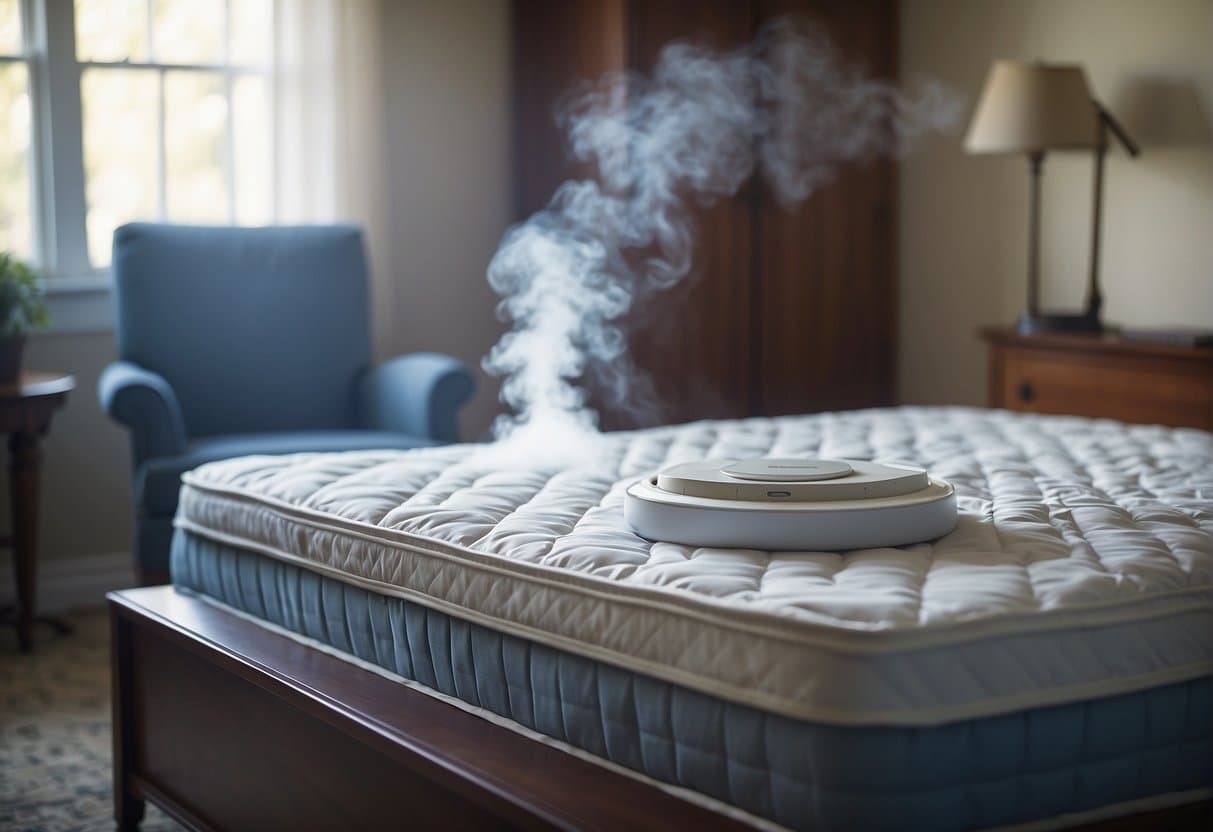
Assessing the success of steam-based treatments for bed bugs is vital after implementation. Confirming the elimination of these unwanted pests requires monitoring the treated area closely. It’s essential to remain vigilant to prevent re-infestation, as even a single surviving bed bug can lead to a full-scale comeback.
Identifying Elimination of Infestation
After steam treatment, conduct a thorough examination of the treated areas to verify the absence of bed bugs. The high heat generated by steam is lethal to these pests, typically exceeding 120°C. However, it’s essential to recognize that the effectiveness of steam therapy depends on its application and surface type. For instance, upholstery items like mattresses or sofas may require specialized attention when utilizing a steam cleaner.
Confirm that live bed bugs are no longer present, and inspect for any residual eggs or larvae. Consider the time commitment required, as a single session might not be sufficient. Repeated treatments spaced hours apart or the following day are often recommended to ensure thorough elimination. Don’t underestimate the importance of persistence in identifying hiding spots and preventing rapid multiplication. With consistent effort, you can achieve a bed bug-free environment.
Long-Term Monitoring and Assessment
After eradicating visible bed bugs, it’s crucial to maintain vigilance through continuous monitoring. Bed bugs are notorious for their ability to reappear, making regular checks essential. Place interceptors under bed legs and inspect them frequently to detect any potential re-infestations. A thorough post-treatment routine should involve regular vacuuming and heat-treating of fabrics and clothing that may harbor hidden pests.
Pay close attention to telltale signs such as tiny bloodstains or bug feces on your sheets, which can indicate a persistent problem. Additionally, steam treatments not only eliminate bed bugs but also reduce dust mites and other allergens, providing an added layer of benefit. While the process may be time-consuming, the peace of mind gained from knowing your home is bed bug-free makes it well worth the effort.
Be diligent in inspecting areas like electrical outlets and other nooks and crannies, as these can serve as perfect hiding spots for intrepid bed bugs. Remember that even after initial success, diligence is key to ensuring bed bugs don’t return. Regularly wash your bedding, vacuum, and perform additional heat treatments if necessary to guarantee a bed bug-free home.
Advantages of Steam Treatment Over Other Methods
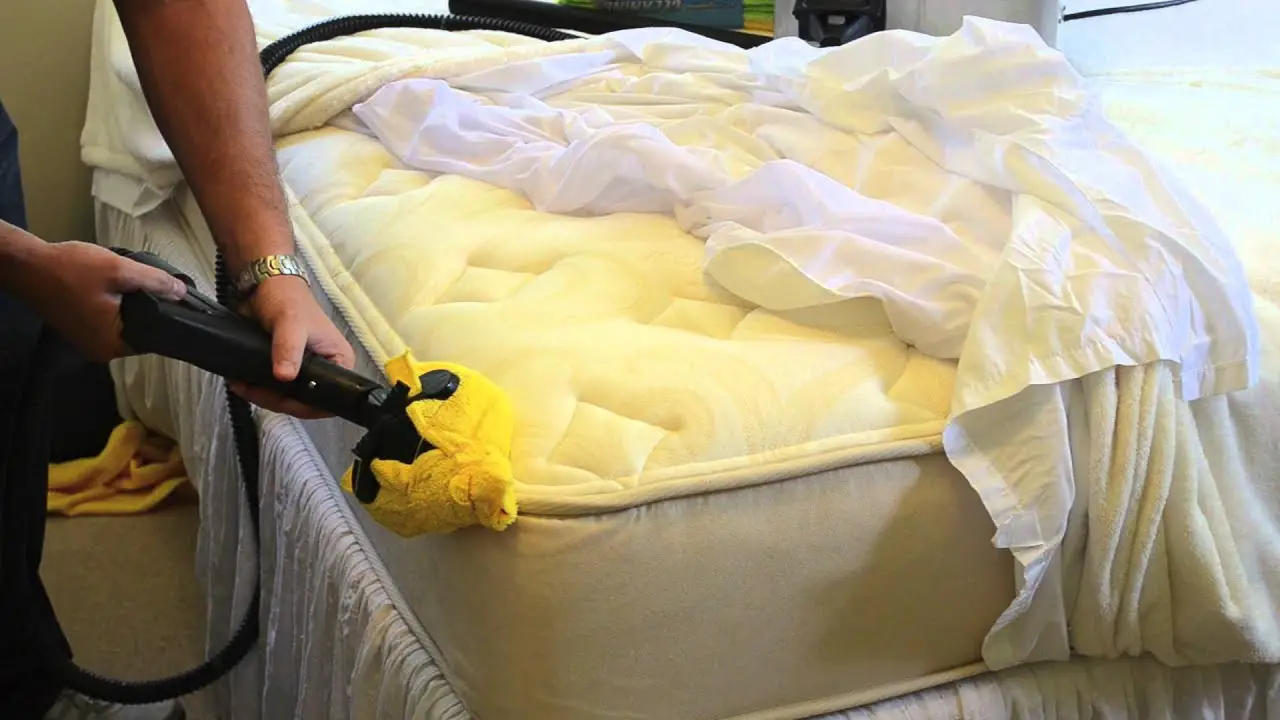
Steam treatment has emerged as a game-changer in the battle against bed bugs, boasting impressive effectiveness while being environmentally friendly. As we delve deeper, it becomes clear that this approach not only outperforms traditional methods but also offers a more sustainable solution for those seeking to eradicate these pesky pests.
Effectiveness Against Pests
Steam treatment proves a potent tool in pest control, targeting bed bugs across all life stages. Heat has long been recognized as a reliable killer of these unwanted critters, and steam cleaners deliver temperatures well exceeding the fatal threshold for bed bugs – a scorching 118°F (48°C). By penetrating even the tiniest crevices and cracks, steam reaches bugs that might otherwise evade detection by chemical treatments.
Techniques involve applying steam at a steady pace to infested areas, ensuring that every last hiding pest is eliminated. For instance, heat’s effectiveness in killing bed bugs lies in its ability to render them incapacitated at a genetic level, making immediate resurgence impossible.
Environmental and Health Benefits
Unlike traditional chemical treatments that can pose health risks and contaminate indoor air, steam cleaning leverages the natural power of water vapor. This eco-friendly approach ensures improved indoor air quality and reduces the risk of health issues. Additionally, steam treatments are free from toxins and pollutants, safeguarding both human health and the environment.
For those prioritizing a chemical-free living space, steam cleaning offers a refreshing solution that not only purifies surfaces but also eliminates harsh chemicals. This method is particularly suitable for households with children, pets, or individuals sensitive to pesticides, as it provides a safe and gentle way to maintain a clean and healthy home.
Frequently Asked Questions
Steam treatment is an effective, chemical-free solution for eradicating bed bugs, providing instantaneous results. To better understand the benefits of this approach, let’s delve into some frequently asked questions and their answers.
What type of steamer is most effective for eliminating bed bugs?
For optimal results in bed bug elimination, it’s crucial to utilize steamers that can generate extremely high temperatures, as these pests are particularly vulnerable to heat around the 120°F mark. When it comes to tackling infestations effectively, heavy-duty steamers with ample tank capacity play a vital role, as they enable sustained heat treatment that leaves no bed bug behind.
To further illustrate this point, some top-of-the-line steamers can boast an impressive temperature of up to 316°F, allowing them to rapidly annihilate bed bugs on contact, providing a thorough and efficient treatment.
How quickly does steam treatment exterminate bed bugs?
Steam has been proven to be a highly effective method for eliminating bed bugs, as it can reach into even the smallest cracks and crevices where these pests often hide. The intense heat produced by steam cleaners allows for rapid eradication of bed bugs, making it a quick and efficient solution compared to other methods.
Can steam from an iron be used to successfully eradicate bed bugs?
While steam from an iron can indeed be employed as a viable method for targeting bed bugs due to its capacity to produce high temperatures, it’s crucial to utilize the iron’s steam setting with care and deliberation to ensure thorough coverage of all potential hotspots and achieve desired outcomes. This involves a systematic approach to tackling the problem head-on.
Is it possible for steam to destroy both bed bugs and their eggs?
To effectively eliminate bed bugs and their nymphs, steam treatment is a viable option. However, it’s essential to note that eggs may require additional attention, as they can survive the heat. When using steam, it’s crucial to ensure that the steam penetrates deeply enough to kill these eggs. For optimal results, consider combining steam with other methods, such as insecticide sprays, to create a multi-faceted approach that addresses all stages of bed bug development.
What surfaces can safely be treated with steam to kill bed bugs?
When it comes to utilizing the power of steam cleaning, many everyday surfaces can be safely treated with this method. This includes a range of household items such as mattresses, couches, curtains, carpets, and baseboards. However, it is crucial to exercise caution when steaming delicate fabrics or materials that may be susceptible to high heat or moisture. With proper care and attention, steam cleaning can be an effective way to sanitize and refresh these surfaces without causing damage.
Are there any commercial steamers recommended for large-scale bed bug removal?
When it comes to tackling widespread infestations or large-scale operations, commercial-grade steam cleaners with robust tank capacities and potent heating performance are the way to go. These high-powered machines deliver consistent steam output over a wide area, making them an ideal choice for treating commercial spaces or severe pest infestations that require intense treatment.






